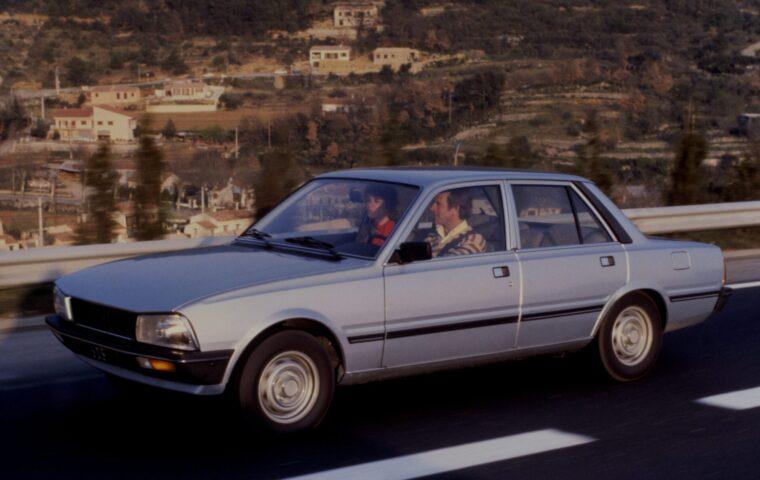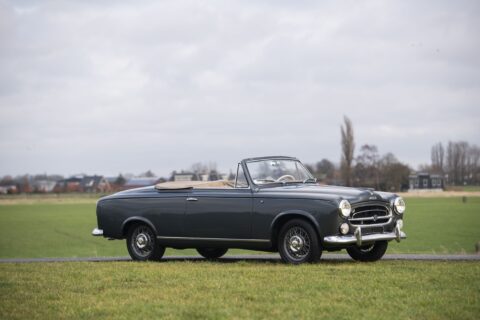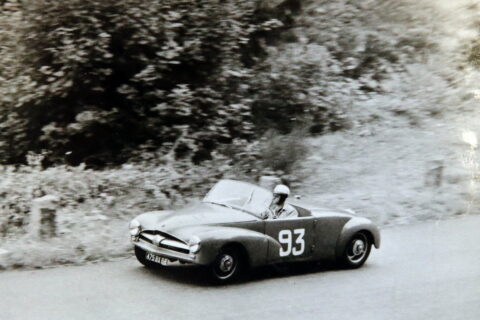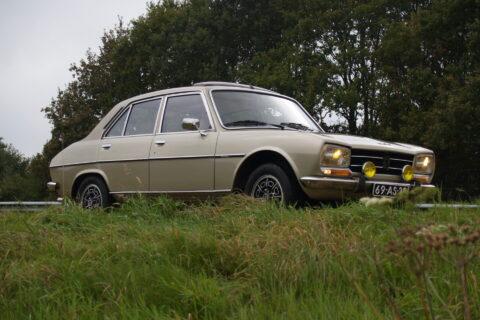During the development of the 505, Peugeot is organizing four ‘clinic tests’ of the prototypes. These tests are held in 1977. In addition to these ‘clinic tests’, there have been a number of other market researches. During the tests, more than 50% of the respondents immediately recognize the new car as a Peugeot.

In 1974, Automobiles Peugeot began developing a successor to the 504. The Peugeot 504 was on the market for 6 years at that time. Peugeot has invited its own Paris styling center La Garenne and the Italian designer Pininfarina to make a number of proposals. The initial goal is to refresh the 504, but eventually Peugeot develops an entirely new model. Between 1974 and 1976, various proposals were made by Peugeot’s own design studio in La Garenne as well as by the Italian Pininfarina. Both design teams are busy with the design of the future 505. Ultimately Pininfarina comes with a mock-up that is different from the Peugeot model. The front revives the front of the 504. The Peugeot management opts for the Pininfarina model. The 504-inspired front of the car has been instrumental in this choice. In January 1977 Pininfarina designs the Break version.
On May 16, 1979, the Peugeot 505 was ready and the car was presented to the international car press in Paris. The Peugeot management indicates that the 505 is partially positioned in a new market segment. The car is between 504 and 604. In 1979 the 505 comes in 6 versions on the Dutch market. First of all, the manufacturer distinguishes the GR version and the SR version. Both models are equipped with a carburettor engine, but the SR is more luxurious than the GR version. In addition, the Ti and the STi are available. These two versions are equipped with a 1995 cc petrol engine with petrol injection. In the field of diesel, there is initially a choice between a GRD and an SRD. Finally, a 505 STi is available with all the extras such as leather, sunroof and automatic transmission.
In 1980 nothing changes to the 505 range. The first additions followed in 1981. Peugeot introduced the 505 SRD Turbo in 1981. The 505 SRD Turbo comes with a 2304 cm3 four-cylinder diesel engine. A 5-speed gearbox is fitted as standard, but an automatic ZF gearbox can be supplied at an additional cost. In the second half of 1981 another version is added to the 505 range: the cheap 505 GL.
In 1982 the big news for the 505 series was the expansion with the 505 Break and the 505 Familiale. The Break, as Peugeot’s estate cars are called, are very spacious. The 505 Break was even the most spacious Estate in its class. Peugeot advertises with the slogan “the most spacious Break in Europe”. A number of minor changes follow in the 1983 model year. The model line has been supplemented with four new versions: a 505 GL 1.8, a 505 GL automatic, a 505 Break GR automatic and a 505 GL Diesel. In addition, the 505 Crystal, the first action model of the 505 series, will be launched. All 505s get a new grille in 1983. After the summer, the 505 Turbo Injection will hit the French market as an absolute winner. This car is equipped with a 2,155cc Chrysler engine with Garrett turbocharger and has an output of 160 hp. Finally, the 505 Commercial is launched.
The first improvements to the Peugeot 505 are made in 1984. The improvements take place on three fronts. Firstly, the engines are addressed, then the suspension and finally details of the appearance are also changed. However, from March 15, 1984, the exclusive 505 Turbo Injection is also available in our country. The car that comes on the market in the Netherlands is technically different from the model that was in Amsterdam a year earlier. The price of the Peugeot 505 Turbo Injection is set at 46,995 guilders. The 505 Turbo Injection is available in two color combinations: Winchester gray / silver gray and Winchester gray / ice blue.

At the beginning of 1985, the 505 range consists of 42 versions. Based on the versions GL, GLD GR, GRD, GTI, GTD and Turbo Injection and the body variants Sedan and Break, 42 versions can be put together, with or without the addition of power steering and / or a sliding roof. New this year were the 505 GRD and the 505 GTD Turbo automatic transmission. The 4-speed version of the 505 GLD is discontinued. The 505 GRD is positioned between the cheaper GLD and the faster GRD turbo. In order to maintain sales figures, the renewed Peugeot 505 was presented after the summer of 1985, after the factory holidays and in the 1986 model year. The car is introduced as “the unexpected discovery”. The 505 has been modified in many areas. First, the appearance of the car has been overhauled. The car looks more modern, but retains its characteristic lines.
In 1986 a new action model follows: the 505 Select. The 505 GL 1.8 is used as the basis for the Peugeot 505 SX Select. In 1985, Peugeot’s flagship 604 is already out of production, but for 1986 there are still cars in stock. After that, the 505 V6 must temporarily take the place of the top model. From the 1987 model year, the 505 GTD Turbo is equipped with the XD 3 TE engine, an evolution of the XD 3 T. The main difference of the engine compared to the old one is the mounting of an intercooler on the XD 3 TE engine for cooling the intake air. At the end of 1986, to be precise on October 22, Peugeot Talbot Nederland N.V. announces the arrival of a new series of 505 SX Select. This time the importer delivers the 505 SX Select 2.0. The introduction of the SX Select is a further step on the success of the 505 SX Select 1.8 earlier in the year. The French company Dangel also starts production of the 505 4X4 Break. Over 5500 cars are being built by Dangel.
From 1988 the place of the Peugeot 505 was gradually taken over by the Peugeot 405, the Car of the Year 1988. A new action model, the 505 Magnum, should maintain the interest in the 505. The 505 series will be fitted with a catalytic converter on a large number of models from 1989 onwards. In addition, the 505 range is undergoing a number of final changes. The 505 SX is now also available with the smaller 1.8 petrol engine. The 505 GTi is now called 505 GT injection. In the course of 1989 Peugeot introduced the 605 on the French market and the number of available versions of the 505 was reduced. At the beginning of 1990, the 505 Sedan was put aside by the new Peugeot 605.
In 1991 the thinning continues. The Break and Familiale are only available in two versions: the 505 Break SX or the 505 Break SXD. Both models are also available as an 8-seater Familiale. On March 9, 1992, the last 505 is registered, it is a 2.5 D Commercial. Then it is really over.
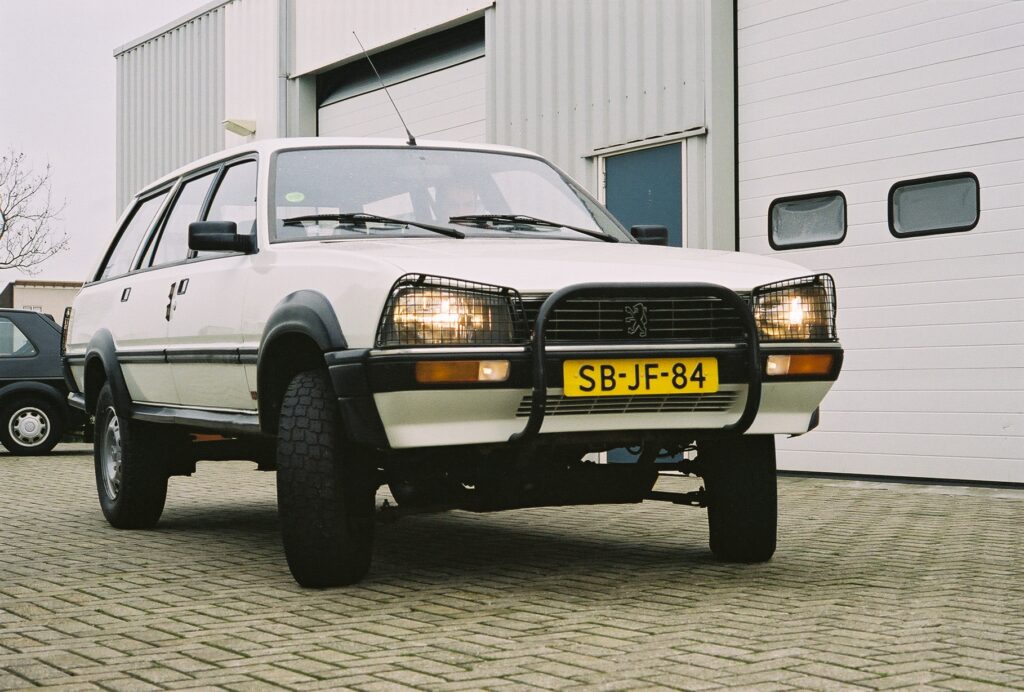
From 1988 the place of the Peugeot 505 was gradually taken over by the Peugeot 405, the Car of the Year 1988. A new action model, the 505 Magnum, should maintain the interest in the 505. The 505 series will be fitted with a catalytic converter on a large number of models from 1989 onwards. In addition, the 505 range is undergoing a number of final changes. The 505 SX is now also available with the smaller 1.8 petrol engine. The 505 GTi is now called 505 GT injection. In the course of 1989 Peugeot introduced the 605 on the French market and the number of available versions of the 505 was reduced. At the beginning of 1990, the 505 Sedan was put aside by the new Peugeot 605.
In 1991 the thinning continues. The Break and Familiale are only available in two versions: the 505 Break SX or the 505 Break SXD. Both models are also available as an 8-seater Familiale. On March 9, 1992, the last 505 is registered, it is a 2.5 D Commercial. Then it is really over.


